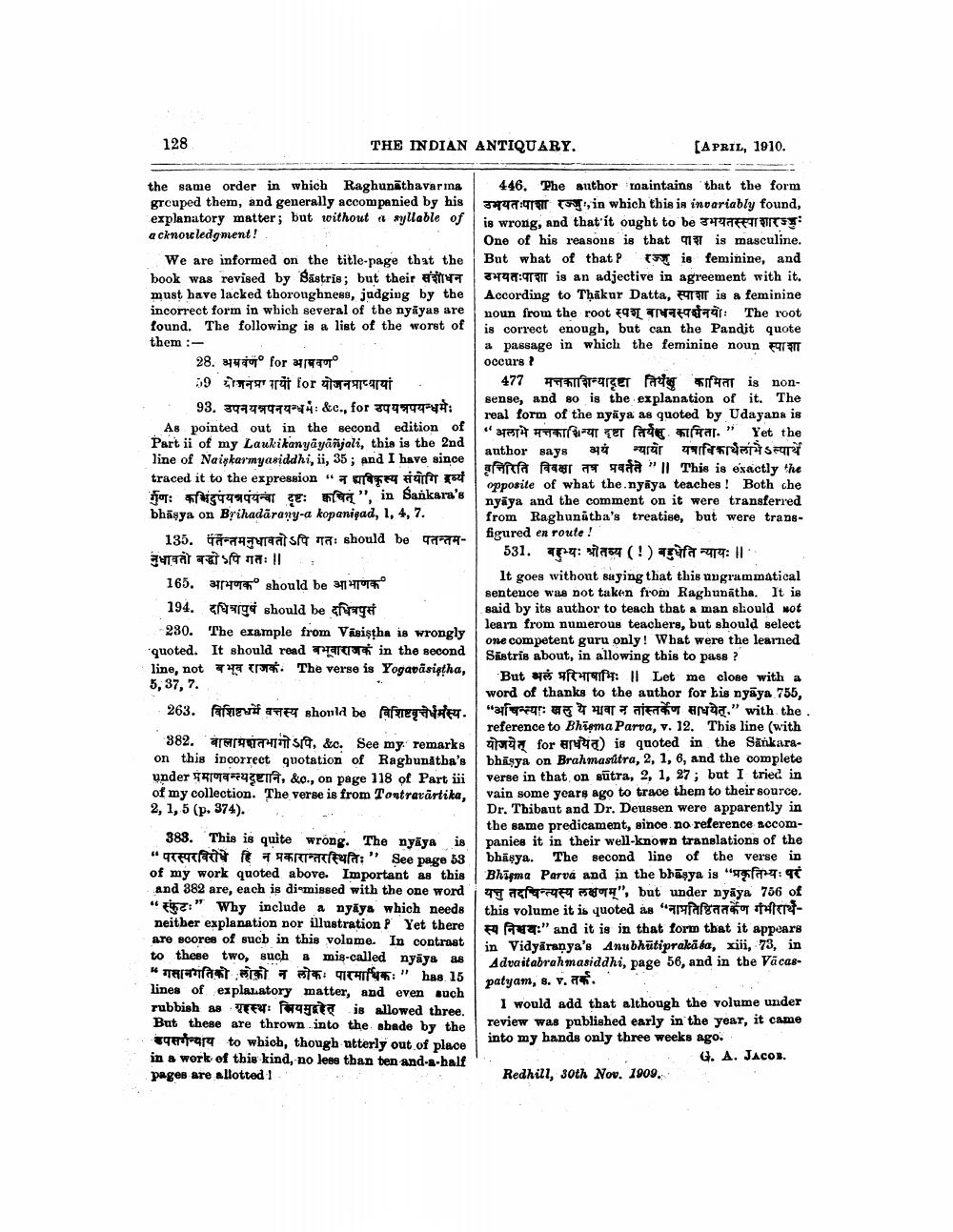________________
128
THE INDIAN ANTIQUARY.
[APRIL, 1910.
the same order in which Raghunathavarma grouped them, and generally accompanied by his explanatory matter; but without « syllable of acknoutledgment!
We are informed on the title-page that the book was revised by Sāstris; but their must have lacked thoroughnese, judging by the incorrect form in which several of the nyāyas are found. The following is a list of the worst of them :
28. 19° for 24/7 39 růt for 1177915779f .
93. 9984997744&c., for 9997447-44: As pointed out in the second edition of Part ii of my Laukikanya yañjali, this is the 2nd line of Naiskarmyasiddhi, ii, 35; and I have since traced it to the expression "
att tact T: 4594-ar ÇE: ".in Bankara's bhāsya on Brihadārany-a kopanigad, 1, 4, 7.
135. 1 aasta ta: should be THनुधावती बद्धोऽपि गतः॥
165. 17° should be 371417 194. go should be firar
280. The example from Vasiştha is wrongly quoted. It should read marca in the second line, not tror. The verse is Yogavāsietha, 5, 37, 7.
263. faevit a shonld be aftree . 382. - 19, &c. See my remarks on this incorrect quotation of Raghunatha's under 57174gEna, &o., on page 118 of Part iii of my collection. The verse is from Tontravārtika, 2, 1, 5 (p. 374).
446. Phe author maintains that the form 44
, in which this is invariably found, is wrong, and that it ought to be
CST: One of his reasons is that 917 is masculine. But what of that
p u is feminine, and 179a:TEIT is an adjective in agreement with it. According to Thakur Datta, FiraT is a feminine noun from the root स्पश् बाधनस्पर्शनयोः The root is correct enough, but can the Pandit quote a passage in which the feminine noun For occurs ?
477 47 GET fata fat is nonsense, and so is the explanation of it. The real form of the nyāya as quoted by Udayana is " Tt - TET . F ar." Yet the author says a rar qurfari SFRY arena paar T qada" Il This is exactly the opposite of what the.nyāya teaches ! Both che nyaya and the comment on it were transferred from Raghunatha's treatise, but were transfigured en route !
531. ap: () agua 24:11
It goes without saying that this ungrammatical sentence was not taken from Raghunatha. It is said by its author to teach that a man should not learn from numerous teachers, but should select one competent guru only! What were the learned Sāstris about, in allowing this to pass ?
But apo ufaft: || Let me close with a word of thanks to the author for his nyāya 755, "a : Taloy ," with the . reference to Bhisma Parva, v. 12. This line (with योजयेत् for साधयेत्) is quoted in the Skikarabhāsya on Brahmasitra, 2, 1, 6, and the complete verse in that on sūtra, 2, 1, 27; but I tried in vain some years ago to trace them to their source. Dr. Thibaut and Dr. Deussen were apparently in the same predicament, since no reference accompanies it in their well-known translations of the bhinya. The second line of the verse in Bhimma Parva and in the bhāşya is " for 4:9
atau ", but under pyāya 756 of this volume it is quoted as "arfafcaa offert R :" and it is in that form that it appears in Vidyaranya's Anubhūtiprakada, xiii, 73, in Advaitabrahmasiddhi, page 56, and in the Vacaspatyam, 8. v.a.
I would add that although the volume under review was published early in the year, it came into my hands only three weeks ago.
G. A. JACOB. Redhill, 30th Nov. 1909.
388. This is quite wrong. The nyÃYA is " qercado P
a rafat:" See page 53 of my work quoted above. Important as this and 882 are, each is dismissed with the one word "$2" Why include a nyaya which needs neither explanation nor illustration P Yet there are scores of sucb in this volume. In contrast to these two, such & mis-called nyaya as * Taraman
fy:" has 15 lines of explanatory matter, and even auch rubbish as EP: 9 is allowed three. But these are thrown into the sbade by the erfar to which, though utterly out of place in a work of this kind, no less than ten and-a-half pages are allotted !




